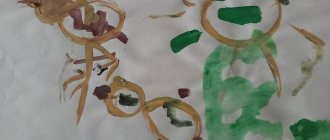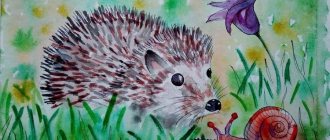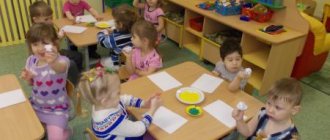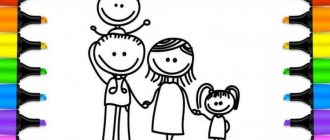Summary of a lesson on unconventional drawing in the second junior group on the topic “Rain”
Summary of the organization of continuous educational activities of children in the second junior group on the topic: Non-traditional drawing with cotton swabs and poking “Rain”
Description of the material: This summary will be of interest to preschool teachers and parents. Intended for use in the second junior group. Can be used as an introduction to the technique of drawing with cotton swabs using the poking method. Goal: Development of artistic creativity in children and activation of creative potential through non-traditional drawing techniques. Objectives of the priority area “Artistic and aesthetic development” - Introduce children to a new technique of creative activity - drawing with cotton swabs - Form creative thinking, sustainable interest in artistic activity - Develop artistic taste, spatial imagination. — To develop the skills and abilities necessary to create creative works. — Develop a desire to experiment, showing vivid cognitive feelings: surprise, doubt, joy from learning new things. Educational objectives in the integration of educational areas “Speech development”: - develop activity in a conversation with a teacher (conversation based on the fairy tale by V. Suteev “Under the Mushroom”)
- develop the ability to hear and understand the question asked
(guessing a riddle, conversation based on the fairy tale by V. Suteev “Under the Mushroom”) mushroom")
- develop the ability to establish simple connections between objects and phenomena
(the mushroom grew because it rained)
- enrich children's vocabulary with adjectives
(small, huge)
and nouns
(rain)
.
“Artistic and aesthetic development”
(musical perception) :
- development of emotional responsiveness - accumulation of musical and auditory experience in children (listening to an audio recording of “Rain” by A. Vivaldi (from the series “Seasons” - a classic for kids) - arouse and maintain interest to music, manifestations of emotional responsiveness, - to cultivate aesthetic feelings
"Physical development" - development of fine motor skills of the hand (drawing with cotton swabs, finger gymnastics "Rain") - help relieve muscle tension (finger gymnastics "Rain") - development of coordination of movements, consolidation of skills run without bumping into each other, strengthening the ability to act on a signal from an adult (p/i “Sun and Rain”) “Social and communicative development” - the ability to interact with each other, with the teacher (p/i “Sun and Rain”); conversation based on the fairy tale by V. Suteev “Under the Mushroom”) - introduction to elementary generally accepted norms and rules of relationships with peers and adults
Planned results of ECD The child is familiar with a new technique of creative activity - drawing with cotton swabs, shows independence in artistic activity; actively interacts with peers and adults; shows curiosity; has basic understanding of the environment; speaks oral language, can use speech to construct a speech utterance in a communication situation; the child can follow rules in different activities; The child has developed gross and fine motor skills, he is mobile, masters basic movements, and can control and manage his movements. Prerequisites for UUD Communicative – the ability to listen and answer questions, seek help from an adult, express gratitude, participate in joint activities; cognitive – the ability to work according to a given algorithm; regulatory – the ability to carry out actions according to a model and a given rule; the ability to listen to an adult and follow his instructions Equipment used 1. A sheet of white A4 paper with a drawn cloud and a small mushroom for each child. 2. Blue gouache in rosettes for each child. 3. Cotton swabs for each child. 4. Napkins for each child. 5. Umbrella for playing. 6. Illustrations (illustration of an ant, illustrations for V. Suteev’s fairy tale “Under the Mushroom”)
7. Audio recording of “Rain” by A. Vivaldi
(from the series “The Seasons” - a classic for kids)
, audio recording of the game “Sun and Rain”
Preliminary work Reading V. Suteev’s fairy tale “Under the Mushroom” Learning finger exercises “Rain” Rain, rain, more fun (I shake the water from my hands)
Drip, drip, don’t be sorry!
Just don't kill us! (they shake their finger)
Don’t knock on the window in vain
(knock on the window)
Better drip on the mushrooms,
(palms down)
So that they grow!
(hands are raised up)
Progress of the lesson
Introductory stage 2 minutes Goal: creating a positive attitude, motivating children for educational activities, promoting the development of movements during the game.
Guys, look how beautiful it is here.
Today we will draw, but first guess the riddle: From a cloud, like from a sieve, Drop by drop, water drips! Right! Rain! Guys, let's play a game called “Sunshine and Rain” (to music)
.
— The sun is shining brightly, the birds are singing, the children are walking. - “Rain!” - children run and hide under an umbrella. - "Sun!" the umbrella closes - the children are “walking”. - Rain! the guys run under the umbrella again. - The sun is shining! Children are “walking” - So our game is over. Sit down at the tables, guys. Main stage 11 minutes Purpose: to introduce children to a new technique of creative activity - drawing with cotton swabs; formation of skills and abilities necessary to create creative works. Practical activities for children. Conversation Guys, who can say what kind of rain it is? The rain can be strong and light. - Remember, you and I read a fairy tale about rain and fungus? — It started raining and almost got you wet? - That's right, an ant. Today an ant came to visit us. Probably the same one that was hiding under the mushroom. - Let's remember the story about the ant: - It began to rain, and where did the ant hide? -What kind of fungus was it? This is how small the mushroom was at first (points to an illustration of a fairy tale on a magnetic board)
- And then what happened?
- Who asked the ant to treat the fungus? - And everyone fit under the little mushroom? - And why? -What did he become? - That's right, big! The fungus has become huge! - Guys, look at your leaves, what do you see there? - What fungus? — What needs to be done to make our mushrooms grow? - Guys, today we will paint not with a brush, but... with cotton swabs like this (shows)
.
Explanation of the method of drawing with cotton swabs. (The teacher shows how to dip a stick in gouache and use the “poke” method to draw rain.)
- Look, I dip the stick in paint and take one small step, raise my hand, take another step next to it, and another one next to it
(Top-top-top)
.
I apply it, tear off my hand, apply it, tear off my hand, and so on until the very bottom, to the very ground. “Now you and I will draw, but first, let’s stretch our fingers.” Finger gymnastics “Rain” Rain, rain, more fun Drip, drip, don’t be sorry! Just don't kill us! Don’t knock on the window in vain. Better drop it on the mushrooms so that they grow! Practical activity - And now, guys, I will give you sticks, and you can draw rain on your pieces of paper. - Do you remember how to draw? (the teacher reminds us of the drawing algorithm)
- Guys, sit down correctly, straighten your backs and let's draw. A sheet with a mushroom and a cloud for each child:
Drawing Algorithm Explanation

Drawing that might come out
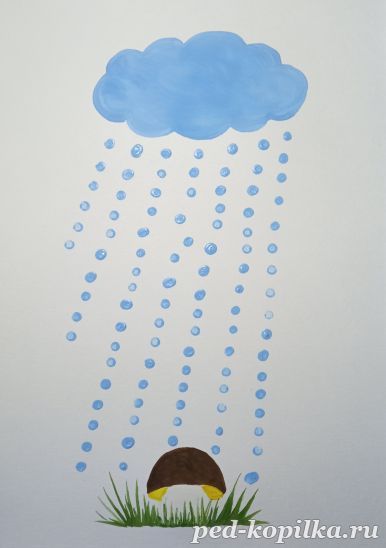
The teacher monitors the completion of the task and helps the children. The teacher introduces a new noun “rain”. While the work is being done, the music of A. Vivaldi “Rain” is played. Final stage 2 minutes Goal: to help relieve emotional and mental stress and increase the emotional mood of students. Children receiving positive assessment of their activities. The teacher sums up the educational work and gives a positive assessment to each student.
All work is posted on the board. - Look how beautiful the rain is for ...
(children's names)
, and for ...
(children's names)
the rain is heavy - a real downpour, mushrooms will grow quickly from such rain!
Well done! — Did you like drawing with cotton swabs? - Now you can paint with both a brush and a cotton swab. - Thank you for helping the mushrooms start growing. - The ant says thank you and goodbye. Application:
We recommend watching:
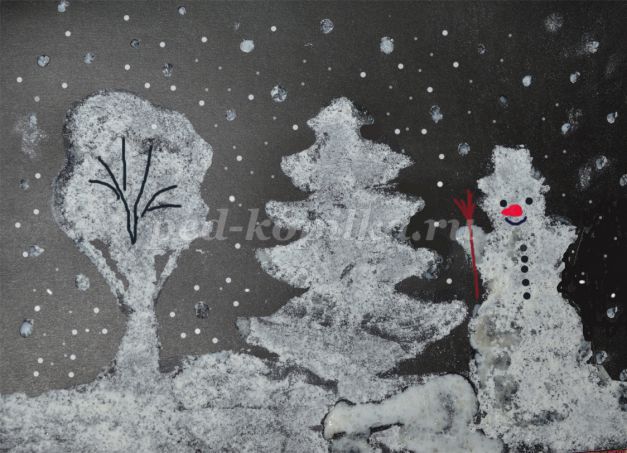
Drawing lesson in the preparatory group. In the winter park Advice for parents of young artists Cats. Drawing lesson for children Application for March 8th for the senior group of kindergarten
Similar articles:
How to develop your child's creativity
Abstract of GCD on communication and mathematical development in the second junior group
How to draw rain with pencil and paints?
Everyone perceives rain differently. It makes some people sad, others have fun jumping in puddles, and others even begin to write poetry, inspired by the gloomy atmosphere. Have you ever wanted to depict this natural phenomenon on paper? Let's look at how to draw rain with a simple pencil and watercolors.
Preparing materials
First, let's lay out on the table in front of us everything that may be useful in the drawing process. The workplace should be well lit and free from unnecessary things.
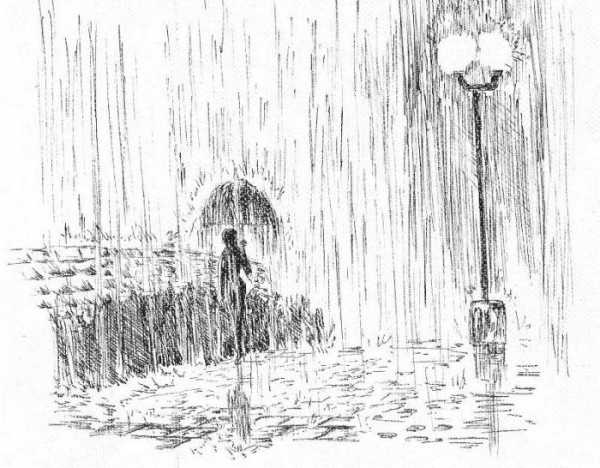
So, what tools will you need:
- Sheets of paper.
- Simple pencils.
- Eraser.
- Colored crayons, pencils, markers or watercolors.
- Tassels.
- Glass of water.
- Palette (small board for mixing paints).
- A picture of rain (if necessary).
Learning what rain looks like
Before you draw rain, you need to get to know it better. This will help make the drawing more realistic. Find different pictures depicting rain, drizzle and look at them carefully. If possible, catch a drop of rain with your hand or clothing. Take a good look at the trail of fallen water. Look what the drop looks like. Is it big or small, round or elongated, transparent or colored? Rain is especially beautiful in sunny weather, when it shimmers with all the colors of the rainbow.
When you draw a shower or drizzle, remember what drops you saw. This will make it easier to concentrate and complete the landscape.
What is characteristic of rain?
Be sure to take into account all the details that need to be drawn. It rains in cloudy or sunny weather, in a wooded area or in an urban area, whether it is strong or not. All this will affect the drawing. If you want to make it realistic, of course.
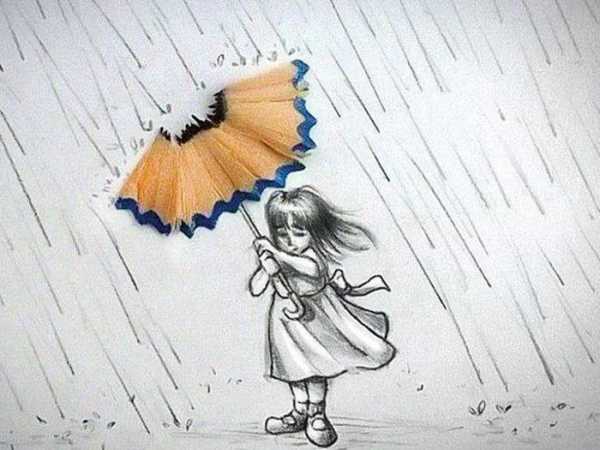
So, what features are important to consider when depicting rain:
- Cloudiness and predominance of gray color.
Usually, when it rains, the sky becomes cloudy so that the sun is no longer visible. In this case, the painting should be done in a restrained color with a predominance of gray. Darker paints should be applied to all painted horizontal surfaces, thus simulating moisture.
- Contrast.
Nearby objects must be clearly reflected in the picture. And background objects will be hidden by the rain, and therefore they will be practically invisible.
- How to draw rain depending on the terrain.
Puddles accumulate faster on asphalt or concrete surfaces. The soil absorbs moisture well. But this does not mean that there is no need to draw puddles in the forest and field at all.
In puddles, even the smallest ones, nearby objects will always be visible. How to depict this on paper? Simply duplicate the mirrored objects with elongated vertical spots.
- Additional attributes.
Rain may be accompanied by lightning, the appearance of circles on the water and people running under umbrellas.
How to draw rain with a pencil in 10 steps
- Step one. First, think about what you want to draw. For example, a person walking in the rain.
- Step two. Mark the horizon line with a pencil.
- Step three. Sketch the silhouette of a man or woman. The head may not be visible because the person is covering himself with a newspaper or umbrella.
- Step four. Sketch an umbrella or newspaper.
- Step five. Mark the background objects (road, houses, clouds, trees, lanterns, and so on).
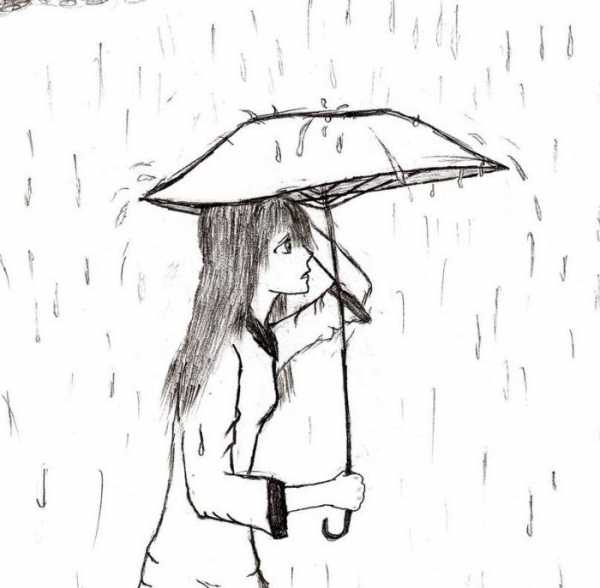
- Step six. Now draw in detail the person with an umbrella (or newspaper).
- Step seven. Use an eraser to erase unnecessary lines.
- Step eight. Draw background objects.
- Step nine. Add shading and shadows.
- Step ten. Draw the rain itself. It can be depicted with frequent hatching, long lines, dashes with curved tips, or ordinary drops. In all the pictures in the article, the rain is drawn differently, pay attention to this.
The pencil drawing is ready. If you wish, you can give it color. By painting only individual objects, you will convey a special atmosphere in the picture.
How to paint rain step by step with watercolors
Let's start painting with paints right away. Don't be afraid to work without a simple pencil! So let's get started.
- Step one. Use gray paint to paint a cloud. This will make it clear where the rain will come from.
- Step two. Dilute the blue paint a little with water on the palette. You should get a liquid consistency, a little runny.
- Step three. Dip the brush into the resulting paint and draw the contours of small drops. Draw in rows in a vertical order, preferably moving from top to bottom.
- Step four. Draw medium sized drops.
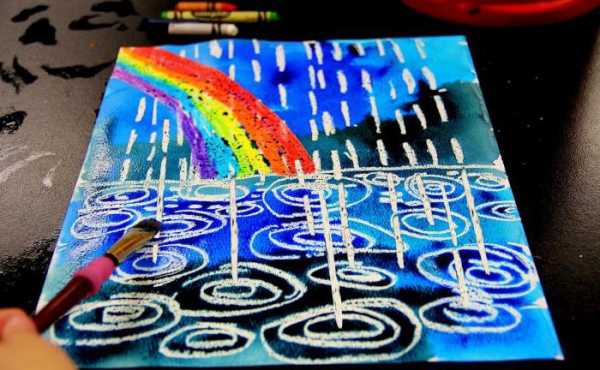
- Step five. And then the biggest ones.
- Step six. Now fill the drops with blue paint, slightly diluted with water. This will give a transparent effect.
- Step seven. Let the drawing dry.
- Step eight. For large and medium drops, add white highlights with a light movement. The rain turned out to be real.
How to draw torrential rain? Decide on the slope of the drops. Draw them with thin vertical lines, one oblique at a time.
As you can see, rainy landscapes are not as difficult as they seem.
fb.ru
How to draw rain? VIDEO hint!
Jan 14, 2014
in Drawing video by Marina Trushnikova
How to draw rain?
Paintings depicting rain are not such a common occurrence in art. But in vain. After all, they have their own poetry and beauty...
4 patterns that are typical for a cloudy rainy day:
1. Cloudy sky , giving a calm, restrained flavor to the whole picture.
Since there is no sun during rain, all objects in the landscape will have a predominantly local color with subtle nuances of color.
The gray color of the sky will be reflected on wet horizontal surfaces and thus predominate.
2. Sharp tonal color transitions.
In a humid environment, foreground objects will have a lot of contrast. And middle ground objects hidden by a veil of rain will be very nuanced. The distant plan may not be visible at all.
As a result, the contrast between the foreground and middle ground will be very significant. And the heavier the rain, the more.
3. Reflections in puddles.
Even a small layer of water on asphalt gives long reflections from objects. The earth absorbs moisture faster, but if there are puddles, they will also reflect the surroundings.
Typically reflections are written in vertical spots, duplicating the reflected object and lengthening it.
4. Circles on the water, drops, streams of rain, umbrellas.
How to draw rain: VIDEO
In general, I can say that painting rainy landscapes is quite simple - general coloring, minimal volume of objects - you don’t need a lot of knowledge and skill here.
And drips of paint and characteristic “rainy” details will complete the look. If the material was useful to you, share it on your social media feeds!
We learn to paint landscapes with rain in detail at the School of Fine Arts! Feel like you're lacking the basics of drawing, painting, and composition?
Then join the training!
izo-life.ru
How to draw rain? | How to draw rain step by step in Photoshop
Rain is drops of water falling from the sky. Water drips from the sky when drops of water unite and can no longer fly in the clouds with all their weight. Clouds consist of steam, while rain consists of the same drops of steam, but combined into larger ones.
There are different types of rain: showers, drizzle, regular rain. Snow can also be called rain, because it consists of the same raindrops, but frozen and icy.
Here I’ll show you how to draw rain , or you can draw rain in Photoshop with a simple pencil.
Let's draw rain step by step:
Step one.
Step two.
Step three.
[nextpage] Step four.
narisovat.com
How to draw rain | rastishka.by
Rain is not a reason to be sad. Let's create rainy masterpieces with the kids! Our ideas will help you!
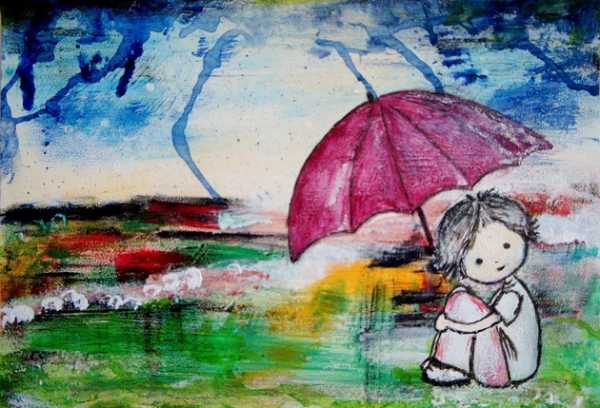
book-with-pictures.blogspot.com.by
Rain is umbrellas. And umbrellas can be different...
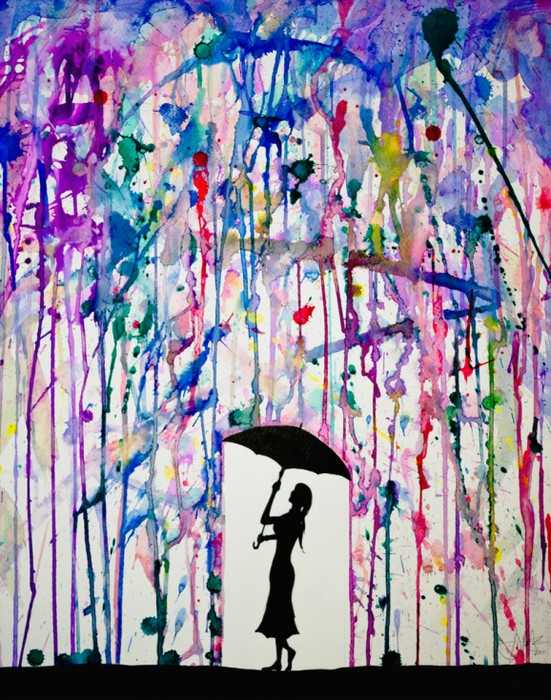
www.marcallante.com
Rain can be amazingly colorful and beautiful. You just need to take a closer look and pick up a watercolor. Rainbow smudges on the sheet - that’s IT!
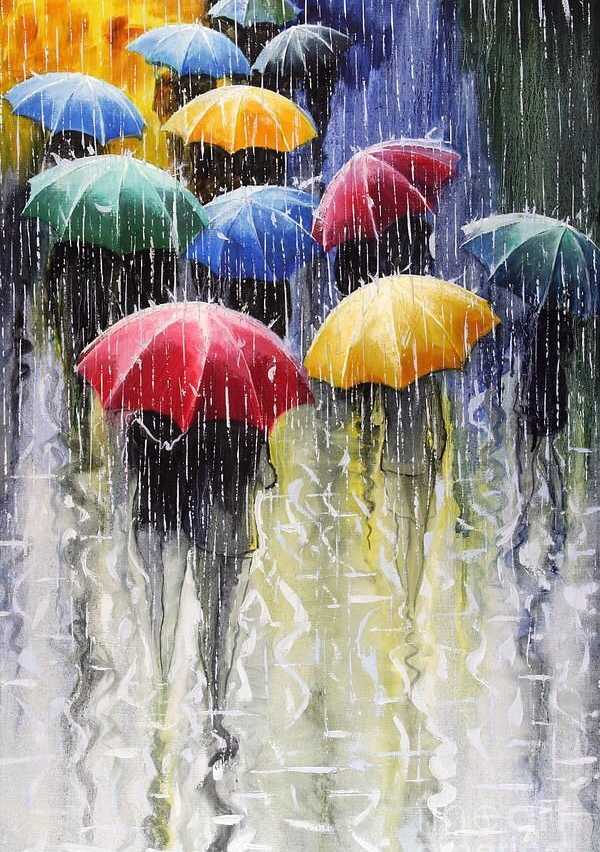
playinart.ru
Paint over the finished work with thick white paint (gouache, acrylic). Here comes the rain! Don't forget about stains on puddles.
Close your eyes and imagine rain. Draw what your imagination tells you.
Even a one-year-old toddler can draw rain this way. Take a sheet of paper folded in half and draw a cloud. Tell a story about how droplets suddenly fell from a cloud - you need to draw them with your finger on one half of the sheet. The breeze blew, the leaf folded and the rain imprinted on the other half!
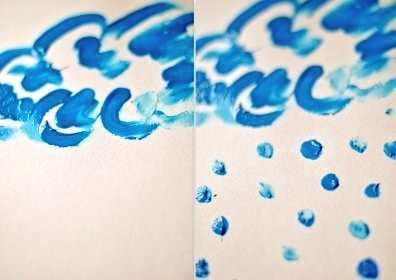
www.moideti.com

rusbatya.ru
Or maybe a young artist would like to draw candy rain? Or strawberry? Or maybe fly agarics are falling from the clouds? The main thing is not to interfere, anything can happen in the life of the Creator, because... HE SEES THIS!!!
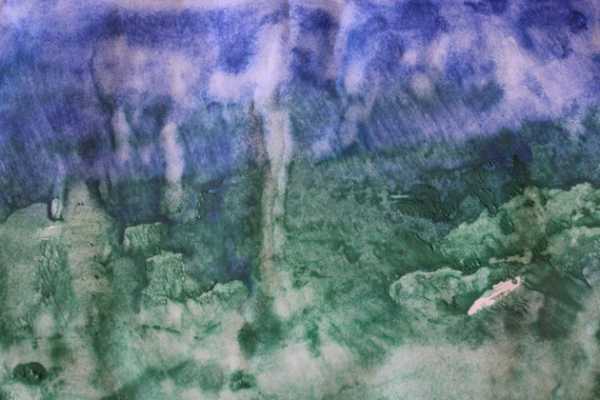
Don't be afraid of dark colors. In rainy weather everything looks exactly like this. While the watercolor is still wet, spray the sheet with water or sprinkle with salt.
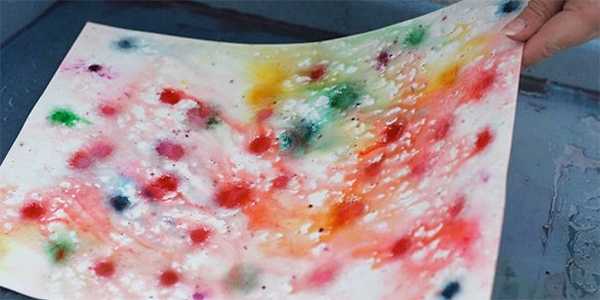
smiletv.org
Rain is a great artist himself! Trust him to create a masterpiece! You can take the finished work out into the rain so that the drops themselves blur the image or...
Take the tray. Put down a sheet of paper. Sprinkle with food coloring or watercolor pencil shavings. Put everything outside and the rain will paint the picture itself!
Dear readers! Have a nice rain on your paintings! Create with your children and share your impressions and creative finds in the comments.
rastishka.by
How to draw rain | Rain and interesting things about rain
Everyone understands that an artist paints rain from memory. No one stands at an easel in a downpour to paint streaks of rain, and yet there are many paintings that depict downpours.
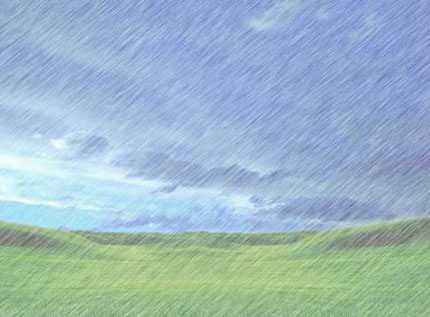
The artist has a special memory, he catches moments with his gaze, they are remembered, and then just close your eyes and imagine the rain, your imagination will draw the necessary pictures.
Draw clouds and rain in the background and foreground
So you close your eyes and think about how to draw rain, and then draw what your imagination tells you. For example, like this: there is a dark cloud in the sky, which means it is a gray felt-tip pen or watercolor paint, which will be of different intensities.
The transitions from gray to darker and less dark should be sharp in some places and smooth in others. Then it will seem that the cloud is alive, it changes every minute.
The smoothness of the transition is achieved by blurring. That is, you should dip your brush into a container of water and blur the watercolor or felt-tip pen. And in places where clouds thicken, the gray color should remain saturated.
But the clouds are not entirely gray, they have blue gaps, sparkling lightning, and whitish torn edges. Therefore, in addition to gray, you should also have these paints on hand.
And rain is a natural phenomenon for which there are few colors in your box. Now you will see this...
Already in the distance, stripes of rain are tracing the sky, this is a wall of rain in the background and how to draw this distant rain? To achieve a realistic image of these stripes or streams, you will have to mix dark blue, gray, dark green colors.
And in the foreground, draw thin trees bending from the wind, tall grass bent by the wind. Complete the composition with a lonely house by the road. Everyone understands that the rain will now come here and pound on the roof, pouring down in a downpour on the trees and the meadow.
How to draw rain in the foreground? He is drawn differently. For example, using the painting technique of blurry spots. You already know how to depict a cloud; in the background we have an aerial perspective, that is, blue in various shades.
In the foreground, in several places, we draw a brush with blue or blue paint and quickly, before it sets, we wash it with water, so that the blue color remains somewhere more saturated, somewhere weakly saturated, and somewhere white Whatman paper remains, or you need apply white paint and apply it with strokes among the blue and blue washes. In such a picture, both trees and houses should also be depicted blurred, but with clear silhouettes.
Rain in the city Rain in the city can be depicted with the help of oblique, as if drawn intermittent streams, which leave a mark on the puddles in the form of dots and circles. How to draw rain using strokes?
This can be seen in the paintings because this technique is used quite often. The strokes are white, gray, light gray, pale blue on a blue, blue and gray background - this is for daytime rain.
And to depict night rain, a black and green background is often used. For evening time, the background can be lilac, with a crimson tint; the artists seem to emphasize the sunset with color.
For those who are interested in how to draw night rain, the following recommendations are given. In the background there is a gray aerial perspective with the addition of dark blue, in the middle ground there are whitish spots, like reflections of lights from lanterns and from car headlights, the car itself with lit headlights, a house with glowing windows. In the foreground there are frequent long strokes and stripes of white, through which the same gray and dark blue background breaks through.
All objects are depicted in muted colors and have some blurring of the image, with the help of this the effect of looking through a veil of rain is achieved.
Rain in the forest
Rain in the forest can also be depicted using strokes and falling drops not only in the air, but also on the leaves of trees, flowing drops on tall blades of grass. Rain in sunny weather is very beautiful, when every drop shimmers like a small rainbow. This effect is achieved by dotted images of highlights of different colors in a transparent drop.
How to draw rain in the light of the sun? This is difficult, because such a picture requires high skill of the creator. Not only color harmony is important here, but also the compositional component. The artist must show the joy of nature, its revival, and the picture must give inspiration to the audience. The bright emerald color of the foliage, the blue color of the sky, and turquoise water are appropriate here.
Thus, rain can be painted with watercolors and felt-tip pens using:
These are only the most common ways of drawing rain, but each artist has his own original artistic practices, his own style. This is the talent of a true artist.
Now you know how to draw rain. Draw it and give yourself and people many different emotions and shades of mood!
odogde.ru
